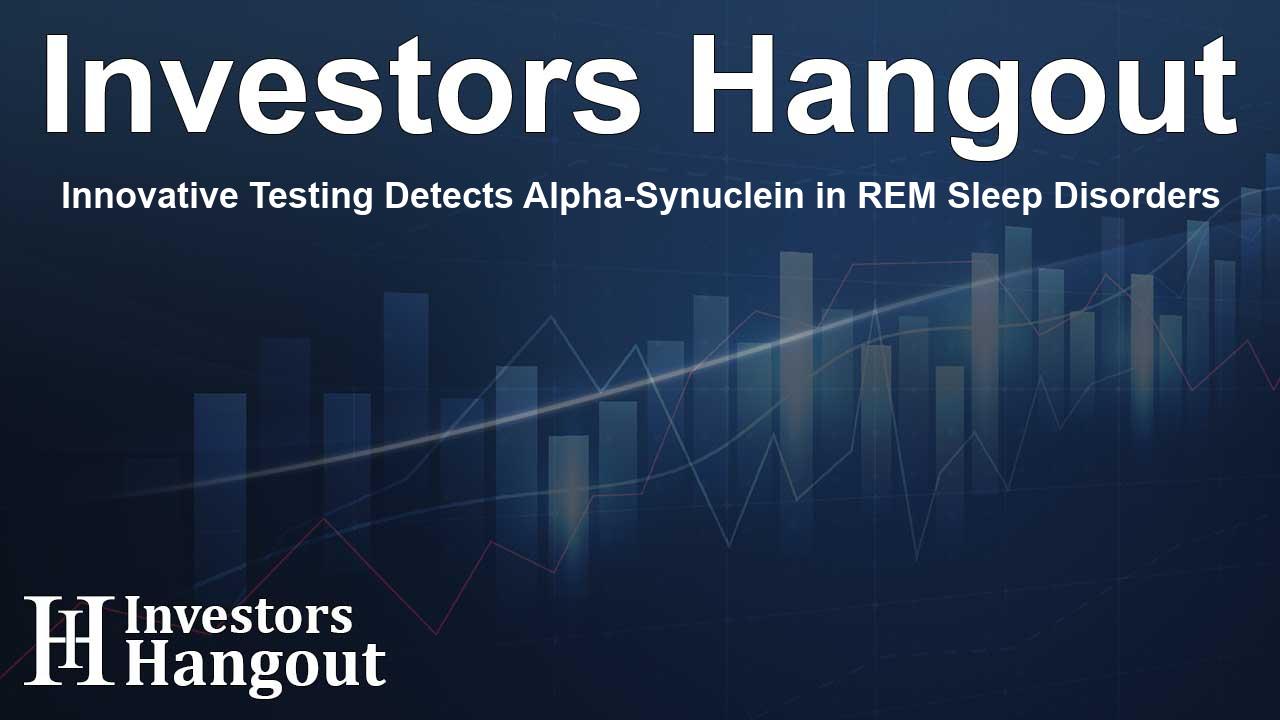Innovative Testing Detects Alpha-Synuclein in REM Sleep Disorders

Innovative Testing Detects Alpha-Synuclein in REM Sleep Disorders
Recent advancements in the field of neurodiagnostic testing have produced significant insights into REM sleep behavior disorder (RBD). CND Life Sciences, a pioneering medical technology firm, has made headlines with the Syn-One Test, which measures phosphorylated alpha-synuclein (P-SYN) in skin biopsies. Results from the Syn-Sleep Study revealed that this test identified P-SYN in 75% of individuals diagnosed with idiopathic REM sleep behavior disorder (iRBD) during the initial assessment.
Understanding the Importance of the Syn-One Test
This innovative study, supported by the National Institutes of Health (NIH), spans 11 different research sites across the nation, enrolling a diverse cohort of 80 participants. The primary objective is to examine the presence of P-SYN in patients exhibiting symptoms of iRBD, a condition that affects individuals’ ability to regulate their actions during dreams, often resulting in vivid and sometimes violent movements during sleep.
Significant Findings from the Study
The initial findings indicate a high detection rate of P-SYN, showcasing the potential of the Syn-One Test as a non-invasive diagnostic tool. With iRBD being a recognized precursor to various neurodegenerative diseases, such as Parkinson's disease and Lewy body dementia, these results underscore the importance of early detection and intervention.
“The Syn-One Test provides a pathway for clinicians to detect potential neurodegenerative disorders before they fully manifest. This marks a shift toward proactive healthcare, where earlier diagnosis can lead to more effective management,” remarked Dr. Michele Tagliati, a neurologist involved with the study.
Exploring Future Implications
As the study progresses, researchers will assess whether the degree of P-SYN found can serve as a reliable biomarker for predicting future phenoconversion to clinically recognized synucleinopathies. Historically, the transition from iRBD to major neurodegeneration occurs in a significant percentage of patients, prompting the need for tools that can not only detect but also forecast neurological decline.
By utilizing the Syn-One Test, participants initially diagnosed with iRBD who harbor P-SYN can be closely monitored for progression of the disorder. Moreover, it opens avenues for potential therapeutic interventions aimed at delaying or preventing the onset of more severe conditions.
CND Life Sciences' Commitment
CND Life Sciences has positioned itself as a leader in the realm of neurodiagnostics, actively participating in clinical trials to evaluate new therapies targeting neurodegenerative diseases. The company’s CLIA-certified laboratory adopts cutting-edge immunofluorescence techniques to visualize and quantify P-SYN, ensuring the reliability and accuracy of its tests.
Presentations at Upcoming Conferences
The findings from the Syn-Sleep Study will be presented at SLEEP 2025, the annual meeting of the Associated Professional Sleep Societies. This presentation will emphasize the significant outcomes of the study, including the implications of P-SYN detection in early diagnosis and aligning treatment protocols.
Key Insights into RBD and P-SYN
The challenges of managing iRBD and its potential progression into more serious neurodegenerative conditions underline the need for research in this area. Current findings suggest that individuals diagnosed with iRBD and detected with P-SYN had been symptomatically affected for an average of 6.7 years. Importantly, this test reveals not only the presence of P-SYN but also potential correlations with other clinical symptoms, such as olfactory dysfunction.
In summary, as CND Life Sciences continues to gather data through the Syn-Sleep Study, the healthcare community anticipates insightful outcomes that could revolutionize how we approach the diagnosis and treatment of sleep-related disorders linked to neurodegeneration.
Frequently Asked Questions
What is the Syn-One Test?
The Syn-One Test is a diagnostic tool developed by CND Life Sciences that detects phosphorylated alpha-synuclein in skin biopsies, aiding in the diagnosis of synucleinopathies.
How does the Syn-Sleep Study contribute to neurodegenerative research?
The study investigates the correlation between beta-synuclein presence in iRBD patients and future risk of developing synucleinopathies, providing vital insights for early intervention.
What is idiopathic REM sleep behavior disorder (iRBD)?
iRBD is a condition where patients act out their dreams, which may indicate a higher risk for later development of various neurodegenerative diseases.
Why is early detection important in iRBD?
Identifying individuals with iRBD can facilitate proactive management, potentially delaying or preventing the onset of severe neurodegenerative conditions.
How can clinicians utilize findings from the Syn-One Test?
Clinicians can assess P-SYN levels in patients to evaluate the risk of developing synucleinopathies, aiding in timely treatment decisions.
About The Author
Contact Hannah Lewis privately here. Or send an email with ATTN: Hannah Lewis as the subject to contact@investorshangout.com.
About Investors Hangout
Investors Hangout is a leading online stock forum for financial discussion and learning, offering a wide range of free tools and resources. It draws in traders of all levels, who exchange market knowledge, investigate trading tactics, and keep an eye on industry developments in real time. Featuring financial articles, stock message boards, quotes, charts, company profiles, and live news updates. Through cooperative learning and a wealth of informational resources, it helps users from novices creating their first portfolios to experts honing their techniques. Join Investors Hangout today: https://investorshangout.com/
The content of this article is based on factual, publicly available information and does not represent legal, financial, or investment advice. Investors Hangout does not offer financial advice, and the author is not a licensed financial advisor. Consult a qualified advisor before making any financial or investment decisions based on this article. This article should not be considered advice to purchase, sell, or hold any securities or other investments. If any of the material provided here is inaccurate, please contact us for corrections.
